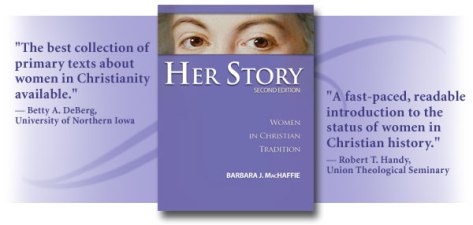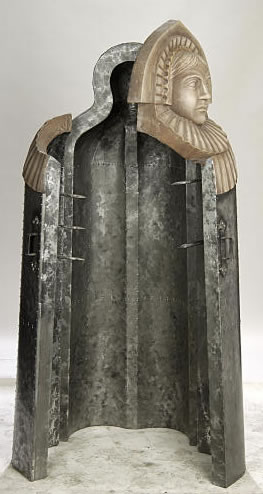During the first two eras of the Christian church, spanning from the death of Christ through the end of the medieval period, women became active participants in the church and then struggled to keep that involvement possible. The first six hundred years of the church is marked by an initial force of women in leadership that is quickly replaced by stringent patriarchal gender roles. These strict gender roles, which continue today in some branches of the church, shaped the dualistic mentality of women and spirituality during the medieval period.
In the decades immediately proceeding the death of Christ, women became heavily involved in church practices, preaching, teaching and leadership. Paul’s letters frequently refer to women workers in the church with the same titles used for men. Phoebe was a deacon (Rom. 16:1) and Junia was an apostle (Rom. 16:7). Priscilla is always mentioned before her husband Aquilla (Rom.16:3). Paul commends Mary, Tryphaena, Tryphosa and Persis for laboring hard in the Lord (Rom. 16:6, 12). Acts 16:14 reveals Lydia, a businesswoman and home church leader. During the ministry of Jesus while on earth, he consistently supports and uplifts women, and women are the followers to continue with Jesus through his death, whereas most of the men depart.
Some of the writings by Paul about women are radical and liberating. In Galatians, he pronounces that there is neither “Jew nor Greek, there is neither slave nor free, there is no male and female” (Gal. 3:28, ESV), which is complete upheaval of the ethnocentricity of Judaism. However, some passages in his letters present a strong antagonism toward women. For example, in Titus 2:3-5, Paul commands older women to be reverent, to work in the home and to teach younger women to love their husbands and children. In Her Story: Women in Christian Tradition, Barbara J. MacHaffie argues that these antagonistic passages are not original to Paul’s letters, and that Paul himself shows an ambivalence toward women and is willing to accept them as peers in leadership (MacHaffie, 14).
Despite the initial prominence of women in the church, within the next few centuries, a new generation of patriarchal church leaders known as the church fathers began to vehemently exclude women from leadership and public roles. Because of the limitations placed on women, after the immediate beginning of the church, there is a near stopgap of information about women’s involvement. The Greco-Roman culture surrounding the early church separated men into public positions of honor and women into private spheres of shame. As the Christian movement further codified into a religion, women were once again relegated into the seclusion of private life (MacHaffie, 16).
The early church fathers believed that women were more prone to sin and that their menstrual cycles associated them with the flesh and fleshly desires. They all plea for virgin lives, and though they do not completely condemn marriage, they tend to view all sexual intercourse as tainted by sin. Thus, sex for procreation was the only permissible sex in their eyes (MacHaffie, 24). Widows occupied a special position within the church during the third century. They were appointed to pray for the church and they laid hands on the sick to pray for healing. Widows were legally independent and had life experience, and sometimes wealth, making them dangerous to the established patriarchal church system, so the official designation of widow eventually dissipated (18).
Virginity was highly regarded by the church fathers, and women could choose to lead a virgin life. This spiritual discipline in women was highly persecuted, and some women who would not consent to marry or to have sex with their new husbands would be martyred for their dissent from social norm. Despite this risk, dedicated virgins gained enough levels of autonomy and admiration within the church that eventually they were cloistered into heavily secluded monasteries (MacHaffie, 25).
This veneration of virginity continued through the medieval period, where it became an obsession. Unmarried women sequestered themselves in their parents’ homes or in cloisters, anchoresses locked themselves into isolation chambers and wives negotiated sexless marriages (MacHaffie, 52-56). Along with virginity, many women also chose asceticism. Through self-starvation, women could control or completely stop their periods, lose the feminine contours of their bodies and appear more and more like men. These ascetics were frequently venerated for their ability to separate themselves from the evil, sexual nature of womanhood (57).
The middle ages saw a rise in a dualistic impression of femininity. Women were either considered to be pure and pious or to be evil and heretical, both by nature of being women. Women who chose the virgin life associated themselves with the Virgin Mary, whose mythology had been growing and exploded during the medieval period. Mary, humble and pious and forever a virgin, interceded for sinful people and pled for grace (MacHaffie, 62). A woman that was not pursuing virginity ran the risk of being labeled a witch. Witch hunts across Europe became common during the later medieval period through the mid eighteenth century, the most famous of which being the Salem Witch Trials in the young British colony of Massachusetts in the 1690s. Witches were believed to be in sexual relationships with the devil, to eat the flesh and drink the blood of children and to pronounce curses on their neighbors that would result in failed crops or miscarriages (65). Though historians believe that this conception of witchcraft was probably never practiced, the image of the witch took root in the ideology of womanhood. Though some men were accused of witchcraft, four times as many women suffered the label through to the point of execution (66).
The medieval period hosted the time of the Christian mystics, a group that was largely dominated by women. Christian mystics received visions directly from God, met with and spoke to Christ and to the saints, including Mary. They received the Eucharist from the hands of Christ himself, lambasting the authority of the church. The famous Christian mystic Julian of Norwich reconceptualizes God and the Trinity in such a way that Jesus, instead of being associated with sonship, is associated with motherhood. Christ is the mother figure who gives spiritual birth to believers and who watches over the believers on earth (MacHaffie, 71). The mystics sought to experience God authentically and powerfully. Despite the womanhood of many mystics, and perhaps because of it, the church accepted their revelations from God as authoritative. The mystics would often describe themselves in denigrating terms, in order to elevate the importance of their messages from God (73).
During these first two major eras of the Christian church, women found ways to subvert patriarchal power and pursue relationships with God. Pursuing virginity and asceticism gave women the opportunity to engage in monasteries and cloisters that would provide education and training in the scriptures. At different moments, women slipped either into leadership positions or the public eye, each time eventually causing further restriction on future generations of women. In order to pursue God and religion, women suffered in denying themselves their sexual natures and by starving themselves to reduce their womanhood. The virgins and the ascetics sacrificed greatly in order to succeed in a patriarchal society.

















